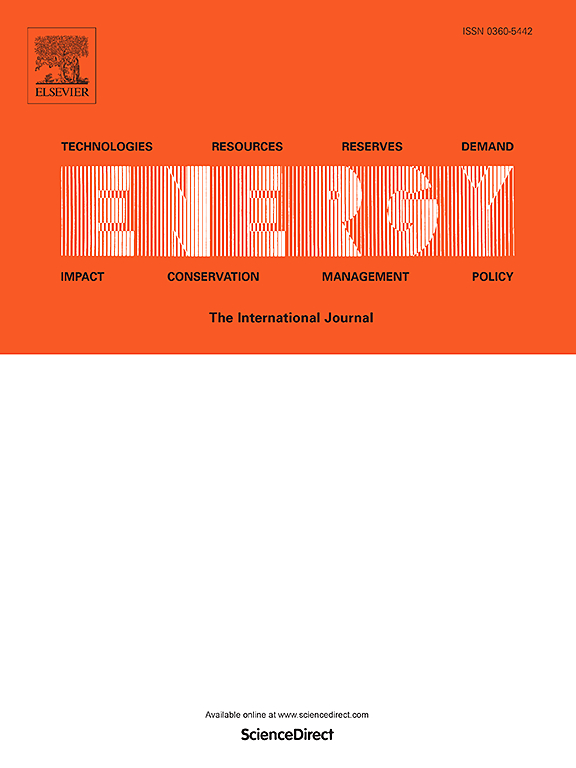Cu3(VO4)2双金属催化剂协同提高了MgH2的储氢性能
IF 9
1区 工程技术
Q1 ENERGY & FUELS
引用次数: 0
摘要
MgH2作为一种固体储氢物质,在未来能源系统中具有广阔的应用前景。本文研究了Cu3(VO4)2作为双金属催化剂在提高MgH2储氢性能中的作用。在吸附和释放氢的过程中,通过反应诱导将Cu3(VO4)2还原为Mg2Cu、MgCu2和VO活性位点,为体系创造了更丰富的催化环境。这些活性位点在促进氢的解离、结合和扩散中起着重要作用。特别是,V种(VO)和Cu种(Mg2Cu, MgCu2)的协同作用克服了氢解离和扩散之间的矛盾关系。结果表明,MgH2-6wt.%Cu3(VO4)2复合材料能够在200℃条件下60 min内释放4.3 wt%的H2,在220℃条件下30 min内释放5.3 wt%的H2,在100℃条件下15 min内吸收4.44 wt%的H2。循环65次后,MgH2-6wt.%Cu3(VO4)2复合材料的吸氢量和解吸氢量分别为5.67%和5.6%,可逆储氢容量保持在94%。本研究揭示了Cu/V双金属氧化物催化剂对Mg/MgH2动力学属性的协同催化作用,为开发实用的镁储氢材料提供了可能。本文章由计算机程序翻译,如有差异,请以英文原文为准。
Cu3(VO4)2 bimetallic catalyst collaboratively improves the hydrogen storage performance of MgH2
MgH2 as a solid hydrogen storage substance has wide application prospects in future energy systems. This study investigates the role of Cu3(VO4)2 as a bimetallic catalyst in enhancing the hydrogen storage performance of MgH2. The Cu3(VO4)2 was reduced to Mg2Cu, MgCu2 and VO active sites during hydrogen absorption and release by reaction induction, creating a richer catalytic environment for the system. These active sites play an important role in promoting hydrogen dissociation, binding and diffusion. In particular, the synergistic effect of V species (VO) and Cu species (Mg2Cu, MgCu2) in overcoming the paradoxical relationship between hydrogen dissociation and diffusion. As a result, the MgH2-6wt.%Cu3(VO4)2 composite is capable of liberating 4.3 wt% H2 within 60 min at 200 °C and further releasing 5.3 wt% within 30 min at 220 °C, in addition to absorbing 4.44 wt% H2 within 15 min at 100 °C. After 65 cycles, the hydrogen absorption and desorption amount of MgH2-6wt.%Cu3(VO4)2 composite are 5.67 wt% and 5.6 wt% respectively, with a reversible hydrogen storage capacity preserved at 94 %. This investigation reveals the cooperative catalytic effect of Cu/V bimetallic oxide catalyst on the kinetic attributes of Mg/MgH2, and provides a possibility for developing practical magnesium hydrogen storage materials.
求助全文
通过发布文献求助,成功后即可免费获取论文全文。
去求助
来源期刊

Energy
工程技术-能源与燃料
CiteScore
15.30
自引率
14.40%
发文量
0
审稿时长
14.2 weeks
期刊介绍:
Energy is a multidisciplinary, international journal that publishes research and analysis in the field of energy engineering. Our aim is to become a leading peer-reviewed platform and a trusted source of information for energy-related topics.
The journal covers a range of areas including mechanical engineering, thermal sciences, and energy analysis. We are particularly interested in research on energy modelling, prediction, integrated energy systems, planning, and management.
Additionally, we welcome papers on energy conservation, efficiency, biomass and bioenergy, renewable energy, electricity supply and demand, energy storage, buildings, and economic and policy issues. These topics should align with our broader multidisciplinary focus.
 求助内容:
求助内容: 应助结果提醒方式:
应助结果提醒方式:


